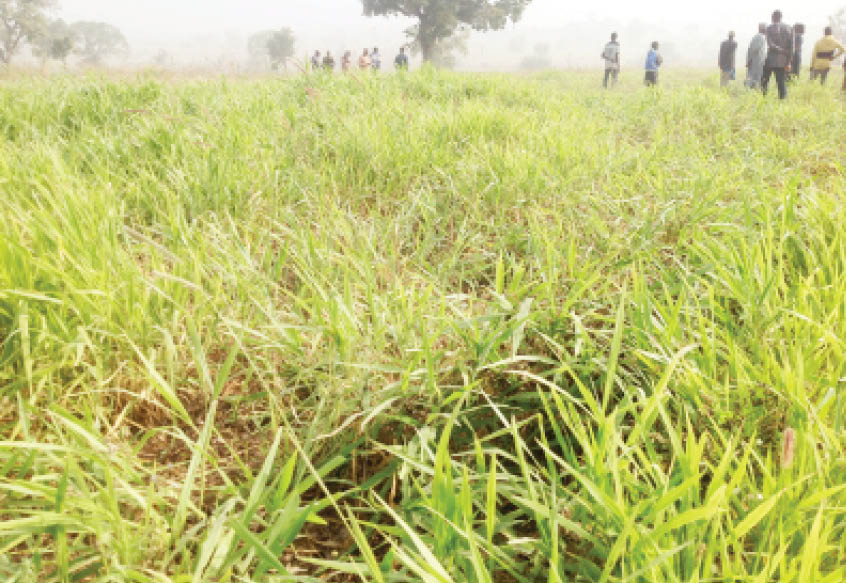Farmers-herders conflict: Niger’s Sheyi Grazing Reserve to the rescue
FAO bringing life to the grazing reserve abandoned for 50 years Over 100 pastoralists to benefit As part of efforts to address the incessant farmers and herders clashes in parts of the country, as well as boosting the livestock industry, the Food and Agricultural Organisation (FAO) department of the United Nations has revived the 50-year-old […]

Pasture grows for animals at the Sheyi Grazing Reserve
-
FAO bringing life to the grazing reserve abandoned for 50 years
-
Over 100 pastoralists to benefit
As part of efforts to address the incessant farmers and herders clashes in parts of the country, as well as boosting the livestock industry, the Food and Agricultural Organisation (FAO) department of the United Nations has revived the 50-year-old three-hectare of Sheyi Grazing Reserve in Sheyi, Shiroro Local Government Area of the Niger State.
It is one of the many grazing reserves in the state but has been left unattended to by successivel administrations, spanning over 50 years since the idea of the reserve was conceived.
However, if the ongoing intervention by the FAO to provide technical support for the takeoff of the reserve under the federal government’s National Livestock Transformation Plan is anything to go by, then the hitherto farmer/herders clashes in the state will soon be a thing of the past.
Apart from solving farmers/herders clashes, the idea behind re-modelling the grazing reserve is to enhance growth in the livestock industries in Nigeria, increase the productivity of the indigenous breed of animals, sufficient and quality feeds, bridge the gap in the dwindling and degradation of natural grazing lands and increase the building of the major stakeholders in the livestock industry.
According to Mallam Jazuli Mohammed Bichi, the national consultant to the projects, the recent climate change and climate variability has greatly affected the traditional grazing lands that were never reseeded with good quality forage materials, leading to the increase transhumant movement. This, he said, formed the basis for the Federal Ministry for Agriculture and Rural Development to request the FAO to provide technical assistance for the implementation of the livestock plan, hence the development of the livestock model.

The international organisation then decided to select the Sheyi grazing reserve in the state as its pilot scheme.
Niger and Kaduna are the two states that have been selected by the international development partner for the intervention for the livestock development model that has been designed to follow an evolutionary process of livestock that is highly dependent on cultural practices, agro-ecology, land availability, supporting infrastructures and resources, such as water and feed soured.
Daily Trust on Sunday learnt that the FAO is assisting the federal government in the implementation of the National Livestock Transformation Programme in Niger State with $245,500 for the re-modelling of the Sheyi Grazing Reserve.
The intervention fund will be used in the area of capacity building of the pastoralists, who are the direct beneficiaries of the reserve, farmers and others along the livestock value chain.
The Sheyi grazing reserve has all the features of a modern reserve, which if properly utilised, would increase the productivity of the indigenous breed of animals, guarantee sufficient and high quality feed, meat and milk production.
The reserve is equipped with solar powered borehole to guarantee regular water for the high breed pasture, parameter fence, pasture developed, reticulated water point for animals and human use as well.
Other facilities at the reserve include drip line for irrigation purposes and accommodation for extension workers.
According to the director of livestock and desk officer of the FAO in the state, Dr Baba Ibrahim, his office has conducted training workshop for no fewer than 55 persons on fodder development, hay making for pastoralists, farmers and extension staff.
Equally, he disclosed that 20 persons had been trained in the area of milk production, processing, hygiene, dairy health, diseases and prevention, cooperative, as well as dairy improvements.
He said, “A training workshop has also been organised for 25 persons, who include pastoralists, farmers and extension agents on pastoralist/farmers field school towards the commencement of the Sheyi Grazing Reserve.”
One of the pastoralists, Mallam GamboIsah, who spoke on the latest happenings in the Sheyi Grazing Reserve, said it was a welcome development since it had become very difficult to embark on open grazing, especially with the current security challenge in the country.
Gambo, who is one of the beneficiaries of the training on pasture development for his animals, believes that modern ranching would greatly reduce the frequent farmers/herders clashes, and pleaded with the FAO to replicate this in other parts of the state and the country in general.
“We can now produce feed for our animals based on the training we had. And we no longer go far with our animals for grazing. This idea will save us from a lot of dangers. It is good for our animals and our physical health,” he said.
He identified water as a major challenge in the reserve since the solar- powered borehole cannot satisfy all the animals, adding, “We need more boreholes in the reserve for our animals to have enough water. It will also help the pasture during the dry season, especially now that the rain has stopped.”
Also speaking, Safiya Mohammed, who had undergone training on modern ways of extracting milk from the cows, said the FAO intervention was a good development as they are equipped with the required knowledge of milk extraction.
Equally, Larai Yusuf, who was trained on how to grow pasture, said she had started earning a living through sales of pasture, adding, “I can now grow grass and sale to pastoralists. Fifty kilograms of bag goes for N1,000, but water is the only challenge facing us, especially now that the rain has gone.”
